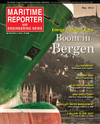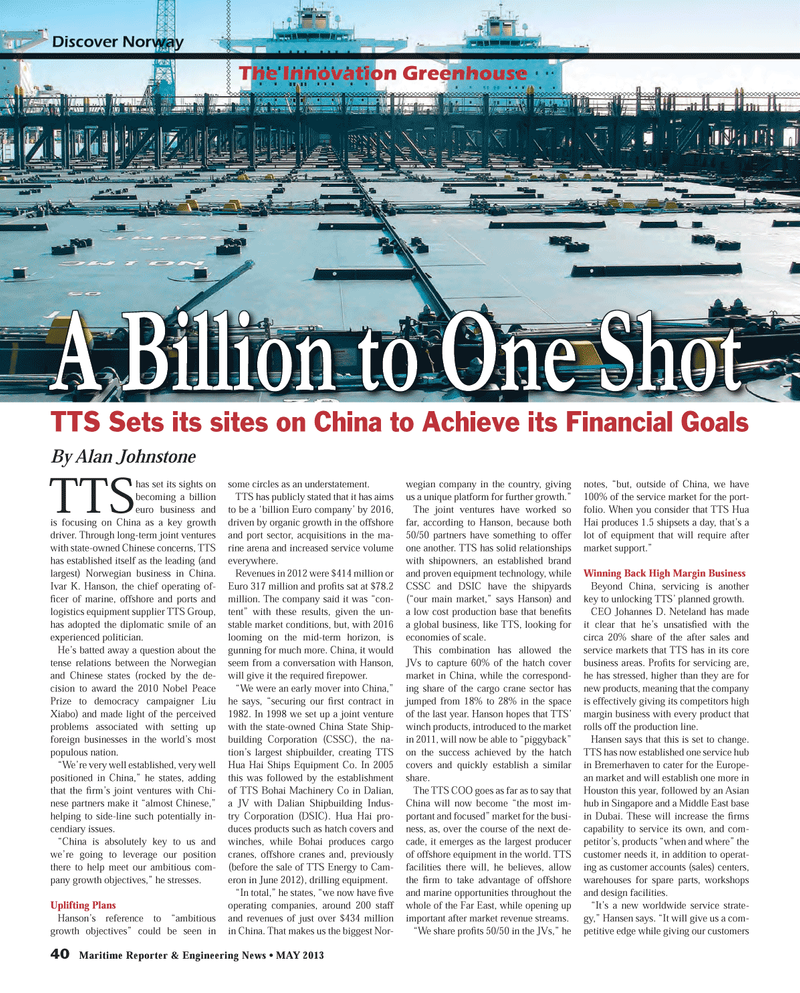
Page 40: of Maritime Reporter Magazine (May 2013)
Energy Production & Transportation
Read this page in Pdf, Flash or Html5 edition of May 2013 Maritime Reporter Magazine
40 Maritime Reporter & Engineering News ? MAY 2013 TTS has set its sights on becoming a billion euro business and is focusing on China as a key growth driver. Through long-term joint ventures with state-owned Chinese concerns, TTS has established itself as the leading (and largest) Norwegian business in China. Ivar K. Hanson, the chief operating of-Þ cer of marine, offshore and ports and logistics equipment supplier TTS Group, has adopted the diplomatic smile of an experienced politician. He?s batted away a question about the tense relations between the Norwegian and Chinese states (rocked by the de-cision to award the 2010 Nobel Peace Prize to democracy campaigner Liu Xiabo) and made light of the perceived problems associated with setting up foreign businesses in the world?s most populous nation.?We?re very well established, very well positioned in China,? he states, adding that the Þ rm?s joint ventures with Chi- nese partners make it ?almost Chinese,? helping to side-line such potentially in-cendiary issues. ?China is absolutely key to us and we?re going to leverage our position there to help meet our ambitious com-pany growth objectives,? he stresses. Uplifting PlansHanson?s reference to ?ambitious growth objectives? could be seen in some circles as an understatement. TTS has publicly stated that it has aims to be a ?billion Euro company? by 2016, driven by organic growth in the offshore and port sector, acquisitions in the ma- rine arena and increased service volume everywhere. Revenues in 2012 were $414 million or Euro 317 million and proÞ ts sat at $78.2 million. The company said it was ?con- tent? with these results, given the un-stable market conditions, but, with 2016 looming on the mid-term horizon, is gunning for much more. China, it would seem from a conversation with Hanson, will give it the required Þ repower. ?We were an early mover into China,? he says, ?securing our Þ rst contract in 1982. In 1998 we set up a joint venture with the state-owned China State Ship-building Corporation (CSSC), the na-tion?s largest shipbuilder, creating TTS Hua Hai Ships Equipment Co. In 2005 this was followed by the establishment of TTS Bohai Machinery Co in Dalian, a JV with Dalian Shipbuilding Indus- try Corporation (DSIC). Hua Hai pro-duces products such as hatch covers and winches, while Bohai produces cargo cranes, offshore cranes and, previously (before the sale of TTS Energy to Cam- eron in June 2012), drilling equipment.?In total,? he states, ?we now have Þ ve operating companies, around 200 staff and revenues of just over $434 million in China. That makes us the biggest Nor- wegian company in the country, giving us a unique platform for further growth.?The joint ventures have worked so far, according to Hanson, because both 50/50 partners have something to offer one another. TTS has solid relationships with shipowners, an established brand and proven equipment technology, while CSSC and DSIC have the shipyards (?our main market,? says Hanson) and a low cost production base that beneÞ ts a global business, like TTS, looking for economies of scale.This combination has allowed the JVs to capture 60% of the hatch cover market in China, while the correspond-ing share of the cargo crane sector has jumped from 18% to 28% in the space of the last year. Hanson hopes that TTS? winch products, introduced to the market in 2011, will now be able to ?piggyback? on the success achieved by the hatch covers and quickly establish a similar share.The TTS COO goes as far as to say that China will now become ?the most im-portant and focused? market for the busi-ness, as, over the course of the next de-cade, it emerges as the largest producer of offshore equipment in the world. TTS facilities there will, he believes, allow the Þ rm to take advantage of offshore and marine opportunities throughout the whole of the Far East, while opening up important after market revenue streams.?We share pro Þ ts 50/50 in the JVs,? he notes, ?but, outside of China, we have 100% of the service market for the port-folio. When you consider that TTS Hua Hai produces 1.5 shipsets a day, that?s a lot of equipment that will require after market support.?Winning Back High Margin Business Beyond China, servicing is another key to unlocking TTS? planned growth. CEO Johannes D. Neteland has made it clear that he?s unsatis Þ ed with the circa 20% share of the after sales and service markets that TTS has in its core business areas. ProÞ ts for servicing are, he has stressed, higher than they are for new products, meaning that the company is effectively giving its competitors high margin business with every product that rolls off the production line. Hansen says that this is set to change. TTS has now established one service hub in Bremerhaven to cater for the Europe-an market and will establish one more in Houston this year, followed by an Asian hub in Singapore and a Middle East base in Dubai. These will increase the Þ rms capability to service its own, and com-petitor?s, products ?when and where? the customer needs it, in addition to operat-ing as customer accounts (sales) centers, warehouses for spare parts, workshops and design facilities.?It?s a new worldwide service strate- gy,? Hansen says. ?It will give us a com- petitive edge while giving our customers Discover NorwayThe Innovation GreenhouseTTS Sets its sites on China to Achieve its Financial GoalsA Billion to One Shot A Billion to One ShotBy Alan Johnstone MR #5 (34-41).indd 40MR #5 (34-41).indd 405/2/2013 9:47:02 AM5/2/2013 9:47:02 AM

 39
39

 41
41
